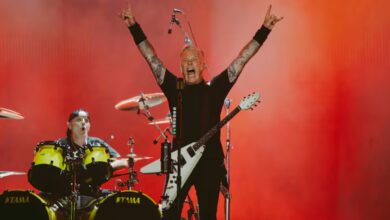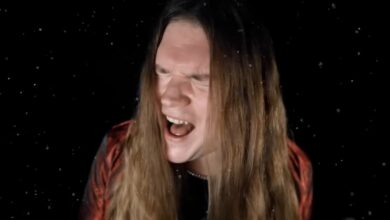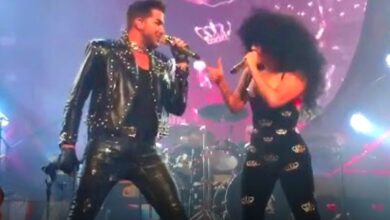Disturbed’s Unforgettable Conan Performance Turns “The Sound of Silence” Into a Once-in-a-Generation Masterpiece
When late March 2016 arrived, few could have predicted that one of America’s most explosive metal acts would trade distortion for restraint. On March 28, 2016, Disturbed took to the stage on Late Night with Conan O’Brien and unveiled a performance that stopped the room cold—a breathtaking reimagining of Simon & Garfunkel’s “The Sound of Silence.” Known for their thunderous anthems and muscular sound, the band stepped into unfamiliar emotional territory that evening, revealing an entirely new dimension of artistry and vulnerability that would redefine their career.
Audience members entering the studio that night likely braced themselves for a wall of sound. Instead, they were met with stillness. The lights dimmed, the stage glowed faintly, and what emerged was not rage, but reverence. David Draiman’s deep, resonant voice carried the song’s opening lines like a confession whispered into eternity. The crowd—conditioned for roaring riffs—sat transfixed, enveloped in an atmosphere so heavy with emotion that silence itself became the loudest thing in the room.
In a moment that blurred the boundaries between generations of artists, Paul Simon himself took notice. Just days after the performance aired, the original songwriter personally reached out to Draiman. On April 1, 2016, Simon sent an email praising the band’s rendition, calling it both powerful and moving. His words carried more than approval—they signified a passing of the torch, a moment of recognition between creators separated by decades but united in purpose.
Draiman’s response was one of visible humility and awe. Publicly expressing his gratitude, he said Simon’s words were among the greatest honors of his life. The band’s goal had never been to reinvent the song, but to pay homage to its emotional core. That mutual respect between artist and originator elevated the moment beyond performance—it became a dialogue across eras, a salute from one craftsman to another.
Originally featured on Disturbed’s sixth album, Immortalized, released in August 2015, the cover had already found immense success before the Conan performance. Against all expectations, it climbed to number 42 on the Billboard Hot 100 and dominated both the Hard Rock Digital Songs and Mainstream Rock charts. For a band defined by power chords and ferocity, such a delicate piece becoming their most commercially successful single was proof of evolution done right.
The studio version—released months earlier in December 2015—showcased a haunting elegance. Guitarist Dan Donegan’s multi-instrumental performance layered guitars, piano, and EBow textures, while drummer Mike Wengren introduced timpani to replace the typical rhythmic assault. The production enveloped Draiman’s baritone with orchestral resonance, turning what could have been a simple reinterpretation into an emotional cathedral of sound. It was both intimate and monumental, fragile yet indestructible.
What unfolded on Conan’s stage wasn’t merely a TV slot—it was revelation. The band transformed a set built for jokes and celebrity interviews into something sacred. Each chord felt carved from silence, each phrase a lament carried on air. As the performance reached its crescendo, Draiman’s voice cracked open like thunder rolling through the quiet. In online fan communities, posts later described it as “a spiritual event in real time,” capturing how profoundly it had touched listeners who expected only entertainment.
Reactions, of course, were mixed, as all art that challenges expectations tends to be. Some critics accused the band of being melodramatic, while others applauded their willingness to abandon safety. What united both sides was acknowledgment—no one could deny the performance’s power. Even detractors admitted that Disturbed’s “Sound of Silence” was unforgettable, precisely because it risked sincerity in an age that often mistakes irony for depth.
From there, the ripple effect was undeniable. By 2017, the single had sold more than one and a half million digital copies and accumulated hundreds of millions of streams worldwide. Its official music video shattered milestones, crossing one billion views, while the Conan performance itself became the show’s most-watched clip with over 150 million views. A simple cover had transformed into a global touchstone, bridging fans of hard rock, folk, and everything in between.
What made that Conan moment historic was its perfect collision of contrasts—metal meeting folk, rawness embracing restraint, 1960s poetry finding rebirth in 21st-century thunder. It wasn’t parody, and it wasn’t pastiche. It was empathy in musical form. Watching a band known for primal aggression channel serenity instead was to witness balance: fire learning to breathe softly. That night’s legacy would outlive the show’s runtime by years.
For Disturbed, the performance symbolized renewal. After their hiatus, Immortalized had already reasserted their dominance, debuting at number one on the Billboard 200. But this song—the quietest track in their arsenal—became the loudest statement of who they were becoming. It reintroduced them not just as a band of volume, but of emotion, proving that aggression and vulnerability could exist side by side without contradiction.
The production team behind Immortalized deserves mention for sculpting this shift. Under Kevin Churko’s guidance, the band leaned into cinematic arrangements and orchestral layering. Strings whispered where guitars once roared. Each element felt purposeful, echoing the band’s growth and confidence. It was a reminder that evolution doesn’t always mean speed—it often means silence, patience, and clarity of intention.
Recognition followed. In 2017, the track earned a Grammy nomination for Best Rock Performance, affirming that even in an era of genre lines and streaming formulas, authenticity still cut through. The nod was more than validation—it was vindication for a creative risk that could have easily backfired but instead solidified their place in rock history.
One can only imagine the shock of Conan’s audience as the band began their haunting rendition. Expecting an onslaught of riffs, they instead found themselves swept into a moment of stillness so heavy it was almost uncomfortable. Yet within that discomfort, something shifted. It was the sound of a crowd realizing that loudness is not measured in decibels, but in depth.
Those in attendance that evening witnessed more than a performance—they witnessed metamorphosis. The transformation of a band, a song, and perhaps even a genre. Couples clutching hands, fans blinking back tears, strangers exchanging glances that said: “We were here when this happened.” It’s the kind of shared revelation that can only occur when art breaks through cynicism and lands straight in the soul.
In the years since, Disturbed’s rendition of “The Sound of Silence” has endured not as a novelty, but as a benchmark. It showed that reinterpretation, when done with reverence and courage, can transcend imitation and become something wholly new. Theirs didn’t replace Simon & Garfunkel’s original—it refracted it, letting a new generation see its light through darker glass.
That night on March 28, 2016, stands frozen in collective memory. A moment when heavy metal and folk poetry met halfway, and something sacred emerged from the meeting. Disturbed didn’t just cover a song; they resurrected it, allowing it to live once again, louder in feeling if quieter in sound. And in doing so, they reminded the world that silence, too, can roar.





